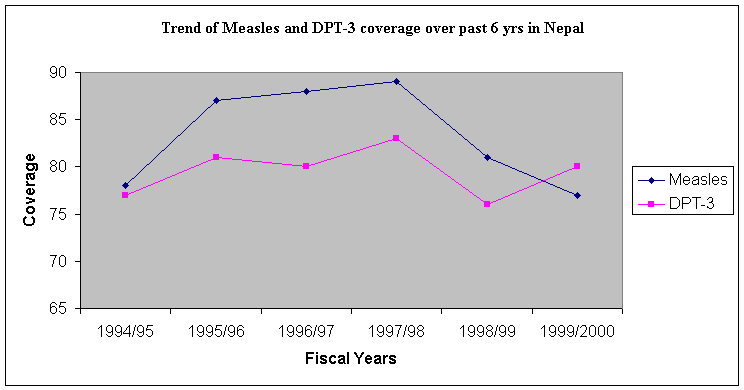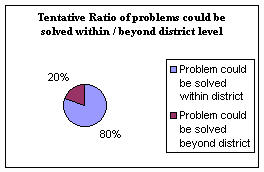
Report of Workshops on Expanded
Program on Immunization (EPI) held at district & Eastern regional level in Nepal.
General Background
Analysis of Coverage of Measles vaccination
Objectives of Workshops
Participants
Problems and Constraints identification
Possible Solutions
Conclusion
General Background
His Majesty's Government, Ministry of Health has given priority to the
Expanded Program on Immunization. Since it is one of the most cost-effective
health interventions, it has achieved reputation of popularity in the population
and interest of planner and managers in the country. One of the immediate
objectives of the EPI program are to reduce Neonatal Tetanus (NNT), to reduce
measles, and to eradicate Poliomyelitis by the year 20001. To achieve
the above objective, EPI program has set targets in all 75 districts for uniform
increases and sustained high levels of homogenous vaccination (at least 80% for
OPV3, DPT3, BCG, and measles in children under one year of age and 80% for TT2
vaccine in pregnant women2. Measles vaccination coverage
in the Eastern region for the fiscal year 2056/57 (1999/2000) was 71.8% and at
national level 76.9%.3 The Annual Report of DoHS (2056/57) has
pointed out that strategies related to EPI are only particularly effective and
coverage is still low for various vaccines. National Immunization Days (NIDs)
can only be successful if generally high population immunity has already been
achieved, a situation that is not possible if large numbers of children are
dropping out of the routine program4. Report has
pointed out that the strategy related to EPI are only partially effective and it
requires revise and update EPI strategy to comply with current and future needs5.
It is also empirically felt that different national campaigns are pushing
regular program towards shadow in districts. The heterogeneous coverage of EPI
within districts is another major problem that has been neglected for years

In accordance to Annual Report of Ministry of Health, Department of Health Services 1999/2000, coverage of Polio-3 vaccination was 80%, DPT-3 80%, Measles 77% and BCG 97%. And as we analyze the reports published by Department of Health Services over past 6 years
we find following fact and figures. Measles coverage in national level was 72% in 1994/95, 87% in 1995/96, 88% in 1996/97, 89% in 1977/98, 81% in 1998/99 and 77% in 1999/2000. Similarly coverage of DPT-3 in national level was 77% in 1994/95, 81% in 1995/96, 80% in 1996/97, 83% in 1997/98, 76% in 1998/99 and 80% in 1999/2000. EPI coverage has generally been observed as downward trends over past six years in Nepal.
Analysis of Measles vaccine coverage of district and its low performing HPs/PHCs.

The heterogenous coverage has been hidden but most considerable issue on the way of achieving the goal of EPI. Sometime the data of a district could mislead the real situation of specific pocket area (VDCs) of the district. For example, Siraha district has reported 87% district coverage but there are still health institutions having coverage of 3% in Siraha HP, 53% in Lahan6. Similarly another example can be taken from Saptari where there are still health institutions having below 60% coverage whereas district overall coverage is 87%7. So, higher achievement of a district coverage does not necessarily assure its homogenous coverage within the district.
Regional and districts Workshop on Strengthening low EPI
coverage.
Writer of this article had also coordinated the regional level EPI training workshop at Biratnagar and district level workshop on strengthening low measles coverage at district level in Sunsari and Morang district on behalf of Eastern Regional Health Services Directorate in December 2001. The article is written based on the above mentioned workshops.
Objectives:
|
|
To review and make them refresh on EPI program. |
Specific Objectives
| Make familiar with the Strategic Guidelines for National Immunization Program of Nepal that aims at streamlining the objectives, targets and strategies for HMG/National Immunization Program (NIP). | |
| To make Plan of Action for strengthening EPI coverage in the years to come. | |
| To make Plan of Action for reducing missed opportunity in the districts. | |
| To make Plan of Action for strengthening Safe Injection practices in the EPI posts. |
|
Participants |
Male |
Female |
Sub-total |
Total |
Regional Level Workshop |
|
DHO/DPHO |
10 |
0 |
10 |
|
|
|
EPI Supervisors |
10 |
0 |
10 |
|
|
|
Cold Chain Assistants |
11 |
1 |
12 |
32 |
|
|
HP/ SHP/ PHC Incharges |
45 |
5 |
50 |
|
Sunsari & Morang Workshop |
|
Cold-Chain Assistants |
2 |
1 |
3 |
53 |
|
|
Grand Total |
85 |
||||
Problems identified causing low coverage of EPI program. There are numerous problems exist in our health system.The immediate causes of low coverage have been identified by District Health Officer, District Public Health Officer, EPI Supervisor, cold-Chain Assistant, Incharges of PHC, HP and Sub Health Posts; can be categorized as follows:
Health workers
EPI Posts
Management
Others
Possible Solutions identified.
Once the causes of low EPI coverage identified by District Health Officer, District Public Health Officer, EPI Supervisor, cold-Chain Assistant, Incharges of PHC, HP and Sub Health Posts have also discovered Possible solution as follows: 
©
2002, Nawaraj Subba.References
1 DoHS, 1999/2000, Annual Report, Kathmandu Nepal, p.21
2 idem
3 DoHS, 1999/2000, Annual Report, Kathmandu Nepal, p.20
4 MOH/DoHS, WHO, UNICEF, 1998, Routine Immunization and NID survey
report, p.14
5. DoHS, 1999/2000, Annual Report, Ministry of Health, Department of
Health Services,Kathmandu, Nepal.
6HMIS / ERHSD, 057/58.
Feedback: nrsubba@hotpop.com